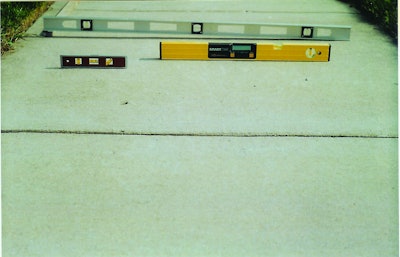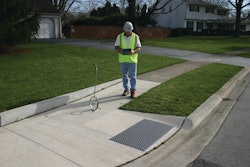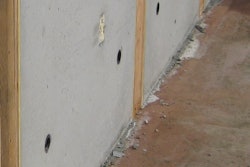
Almost every concrete contractor has a horror story about trying to build sidewalks that meet the requirements of the Americans with Disabilities Act (ADA). One of the most costly problems is meeting requirements for maximum slope because there is no plus tolerance for the maximum cross-slope of 2 percent. Because of this maximum limit, a measured cross-slope of 2.05 percent almost always results in contractors being forced to remove and replace sidewalk sections at their expense.
Because of the need for drainage, a typical sidewalk design might call for a minimum cross-slope of 1.5 percent in addition to the ADA-required maximum of 2 percent. At present it isn't clear whether sidewalks can be built within these limits. In addition to this constructability question, there are two major problems:
- Cross-slopes greater than the 2 percent maximum are not necessarily a hazard to the disabled, and
- There is no standardized method for measuring cross-slope, thus making enforcement measures extremely arbitrary, as will be discussed.
Origins of the 2 percent maximum slope
Was there any research and science used to set the 2 percetn maximum — research based on the stability properties of various wheelchairs, scooters, walkers, or crutches and on the physical condition of the disabled user? Apparently not.
One group of researchers stated the following:
"On the basis of a review of scientific literature on cross-slope deisgn, the conclusion must be drawn that prior research is insufficient to support the ADA 2 percent cross-slope requirement."
"Through the course of this research, the exact history of this 2 percent cross-slope requirement could not be ascertained, and no research and science supporting a unilateral 2 percent requirement was found."
"Results from the most relevant existing reported work, conducted using plywood ramps, can be interpreted to indicate a maximum 'short distance' cross-slope in the neighborhood of 16 to 20 percent. For somewhat longer distances, a reliable upper bound may be closer to 10 percent. When they are considered with the various constraints, these results support the idea that the ADA 2 percent limit might be too strict for relatively infrequent short-distance sidewalk sections such as driveway crossings."1
Given that the 2 percent maximum cross-slope is an arbitrarily chosen number, what is the correct maximum slope? Research results from the University of Texas at Austin provide evidence that a 4 percent maximum cross-slope may accommodate the largest number of possible disabled users.2 The conclusion from this is that rejecting a sidewalk with a cross-slope slightly greater than 2 percent is gross overkill. But because the U.S. Department of Justice enforces the 2 percent slope, cities, states, and private builders must all meet this onerous standard.
Measurement disorder
There is a lack of guidance in ADAAG regarding distances over which to take cross-slope measurements in the field. Inspectors have used any instrument from a 6-inch-long spirit level to an ultra-light inertial profiler equipped with a gyroscope that, by averaging, can estimate the cross-slope over a width of 5 feet or more.3 A the 2-foot-long Smart Tool™ is commonly used for measurements.
Regardless of the tool used, there is no standardized test method for making cross-slope measurements. Any number of measurements may be taken in any area of the sidewalk, and with no rules for averaging measurements, discarding outliers, or treating the data in a standardized manner. Thus, two inspectors from the same agency and using the same tool can record different cross-slopes for a given sidewalk. If one of the readings exceeds 2 percent, it's likely that one will be used and require corrective action.
Problem solutions
Based on the points presented here, three recommendations are as follows:
ADAAG should change their requirements so that the maximum sidewalk cross-slope is 3 percent and the minimum slope is 1.5 percent. Based on the research cited, the 3 percent maximum is reasonable.
The designer can then set a target value of 2.25 percent with a ±0.75 percent tolerance which would reduce the constructability challenge.
Develop a standard method for measuring cross-slope, disseminate it to all agencies or testing firms charged with verifying compliance with ADA requirements, and indicate that no action can be taken unless the standard measurement method has been used.
Until such steps are taken, contractors will continue to be unjustly penalized by the absence of reality-based requirements and arbitrary measurement methods.
References
1. Kockelman et al, "Sidewalk Cross-Slope Requirements of the Americans with Disabilities Act: Literature Review." Transportation Research Record No. 1705, Journal of the Transportation Research Board, pp. 53-60, December 2000.
2. Kockelman et al, "Meeting the intent of ADA in sidewalk cross-slope design," Journal of Rehabilitation Research and Development, Vol. 38, No. 1, January/February 2001, Pages 101–110.
3. City of Bellvue, Washington, "Americans with Disabilities Act (ADA) Sidewalk & Curb Ramp Inventory," Case Study, National Cooperative Highway Research Program (NCHRP), Asset Management Approaches to ADA Compliance, NCHRP 20-07 Task 249.


















